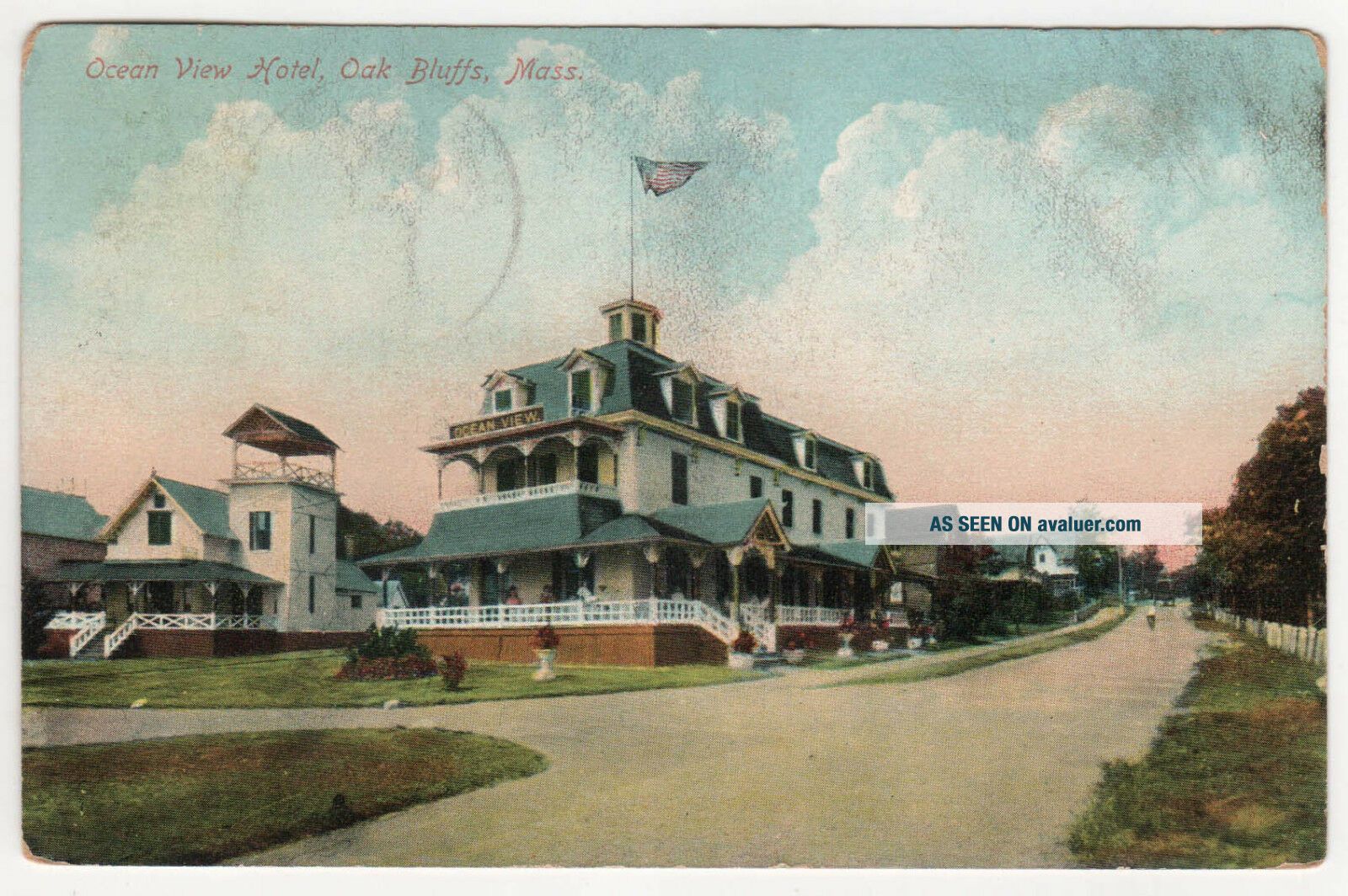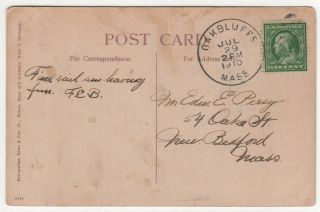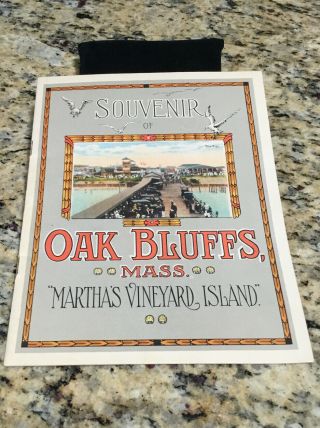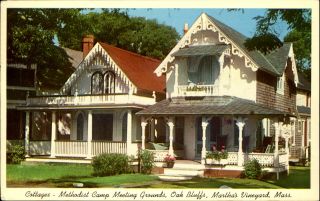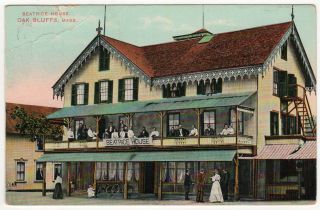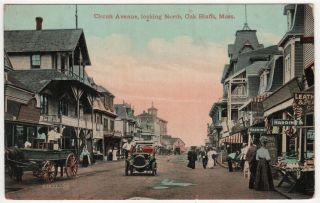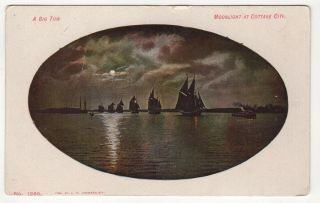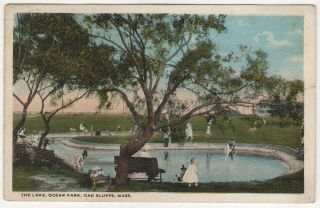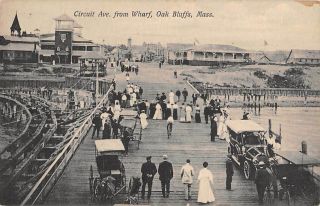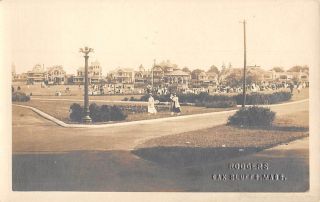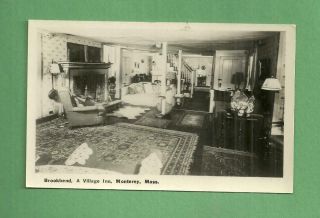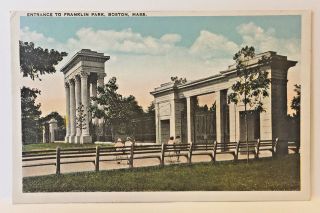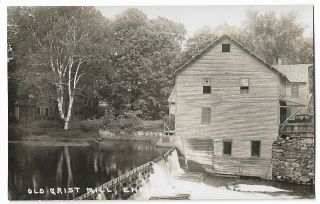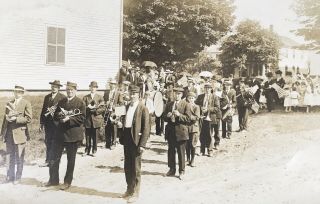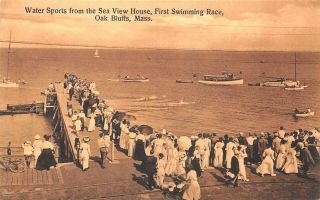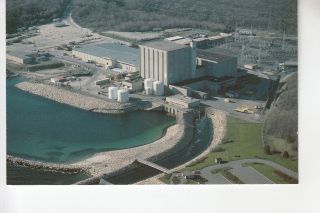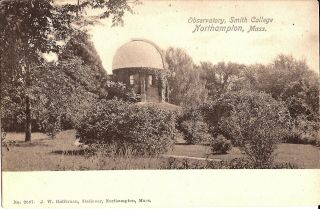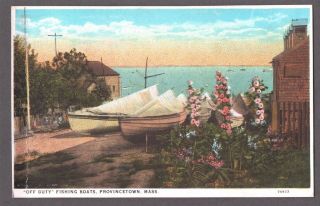1910 OAK BLUFFS MARTHA ' S VINEYARD Massachusetts PC Postcard OCEAN VIEW HOTEL MA
Item History & Price
| Reference Number: Avaluer:3191712 | City/Region: Martha's Vineyard |
| Type: Printed (Lithograph) |
Posted 1910We ship worldwide! Please see all pictures and visit our eBay store and other eBay auctions!Martha's Vineyard (Wampanoag: Noepe; often simply called The Vineyard)[1] is an island located south of Cape Cod in Massachusetts that is known for being an affluent summer colony. Martha's Vineyard includes the smaller Chappaquiddick Island, which is usu...ally connected to the Vineyard, though storms and hurricanes have separated them, as in 2007.[2][3] It is the 58th largest island in the United States, with a land area of 100 square miles (260 km2), and the third-largest on the East Coast of the United States, after Long Island and Mount Desert Island. Martha's Vineyard constitutes the bulk of Dukes County, Massachusetts, which also includes the Elizabeth Islands and the island of Nomans Land.The Vineyard was home to one of the earliest known deaf communities in the United States; consequently, a special sign language, Martha's Vineyard Sign Language, was developed on the island.[4] The 2010 census reported a year-round population of 16, 535 residents, [5] although the summer population can swell to more than 100, 000 people. About 56 percent of the Vineyard's 14, 621 homes are seasonally occupied.[6]Martha's Vineyard is primarily known as a summer colony, and it is only accessible by boat and air. However, its year-round population has considerably increased since the 1960s. The island's year-round population increased about a third each decade from 1970 to 2000, for a total of 145 percent or about 3 percent to 4 percent per year (46 percent, 30 percent, and 29 percent in each respective decade). The population of the Vineyard was 14, 901 in the 2000 Census and was estimated at 15, 582 in 2004. (Dukes County was 14, 987 in 2000 and 15, 669 in 2004).[6] Dukes County includes the six towns on Martha's Vineyard and Gosnold; it increased by more than 10 percent between 2000 and 2010, according to Census data released in 2011, gaining nearly 1, 548 residents. The Island's population increased from 14, 987 to 16, 535.[5]A study by the Martha's Vineyard Commission found that the cost of living on the island is 60 percent higher than the national average, and housing prices are 96 percent higher.[7] A study of housing needs by the Commission found that the average weekly wage on Martha's Vineyard was "71 percent of the state average, the median home price was 54 percent above the state's and the median rent exceeded the state's by 17 percent".[8]Originally inhabited by the Wampanoag people, Martha's Vineyard was known in the Massachusett language as Noepe, or "land amid the streams". In 1642, the Wampanoag numbered somewhere around 3, 000 on the island. By 1764, that number had dropped to 313.[9] A smaller island to the south was named "Martha's Vineyard" by the English explorer Bartholomew Gosnold, who sailed to the island in 1602. The name was later transferred to the main island. It is the eighth-oldest surviving English place-name in the United States.[10] The island's namesake is not definitively known, but it is thought that the island was named after Gosnold's mother-in-law or his daughter, both named Martha.[a]The island was also known as Martin's Vineyard (perhaps after the captain of Gosnold's ship, John Martin); many islanders up to the 18th century called it by this name.[12] The United States Board on Geographic Names worked to standardize placename spellings in the late 19th century, including the dropping of apostrophes. Thus for a time Martha's Vineyard was officially named Marthas Vineyard, but the Board reversed its decision in the early 20th century, making Martha's Vineyard one of the five[13][14] placenames in the United States that takes a possessive apostrophe.[15]
Colonial era
Old Whaling Church, Edgartown Village Historic District
Classicist house next to the Whaling ChurchEnglish settlement began with the purchase of Martha's Vineyard, Nantucket, and the Elizabeth Islands by Thomas Mayhew of Watertown, Massachusetts from two English "owners". He had friendly relations with the Wampanoags on the island, in part because he was careful to honor their land rights. His son, also named Thomas Mayhew, began the first English settlement in 1642 at Great Harbor (later Edgartown, Massachusetts).[citation needed]The younger Mayhew began a relationship with Hiacoomes, a Native American neighbor, which eventually led to Hiacoomes' family converting to Christianity. Ultimately, many of the tribe became Christian, including the pow-wows (spiritual leaders) and sachems (political leaders).[citation needed] During King Philip's War later in the century, the Martha's Vineyard band did not join their tribal relatives in the uprising and remained armed, a testimony to the good relations cultivated by the Mayhews as the leaders of the English colony.[citation needed] In 1657, the younger Thomas Mayhew was drowned when a ship he was travelling in was lost at sea on a voyage to England. Mayhew's grandsons Matthew Mayhew (1648–), John Mayhew (1652–), and other members of his family assisted him in running his business and government.[16] In 1665, Mayhew's lands were included in a grant to the Duke of York. In 1671, a settlement was arranged which allowed Mayhew to continue in his position while placing his territory under the jurisdiction of the Province of New York. In 1682, Matthew Mayhew succeeded his grandfather as Governor and Chief Magistrate, and occasionally preached to the Native Americans. He was also appointed judge of the Court of Common Pleas for Dukes county in 1697, and remained on the bench until 1700. He was judge of probate from 1696 to 1710.[17] In 1683, Dukes County, New York was incorporated, including Martha's Vineyard. In 1691, at the collapse of rule by Sir Edmund Andros and the reorganization of Massachusetts as a royal colony, Dukes County was transferred back to the Province of Massachusetts Bay, and split into the county of Dukes County, Massachusetts and Nantucket County, Massachusetts.[citation needed]Native American literacy in the schools founded by Thomas Mayhew Jr. and taught by Peter Folger, the grandfather of Benjamin Franklin, was such that the first Native American graduates of Harvard were from Martha's Vineyard, including the son of Hiacoomes, Joel Hiacoomes. "The ship Joel Hiacoomes was sailing on, as he was returning to Boston from a trip home shortly before the graduation ceremonies, was found wrecked on the shores of Nantucket Island. Caleb Cheeshahteaumauk, the son of a sachem of Homes Hole, did graduate from Harvard in the class of 1665."[18] Cheeshahteaumauk's Latin address to the corporation (New England Corporation), which begins "Honoratissimi benefactores" (most honored benefactors), has been preserved.[19] In addition to speaking Wampanoag and English, they studied Hebrew, Greek, and Latin. All of the early Native American graduates died shortly after completing their course of study. Many native preachers on the island, however, also preached in the English churches from time to time.[citation needed]
Leavitt Thaxter, Edgartown educatorMayhew's successor as leader of the community was the Hon. Leavitt Thaxter, [20] who married Martha Mayhew, a descendant of Thomas Mayhew, and was an Edgartown educator described by Indian Commissioner John Milton Earle as "a long and steadfast friend to the Indians."[21] After living in Northampton, Thaxter, a lawyer, [22] returned home to Edgartown, where he took over the school founded by his father, Rev. Joseph Thaxter, [23][24] and served in the State House and the Senate, was a member of the Massachusetts Governor's Council and later served as U. S. Customs Collector for Martha's Vineyard.[25] Having rechristened his father's Edgartown school Thaxter Academy, Hon. Leavitt Thaxter was granted on February 15, 1845, the sum of $50-per-year for "the support of William Johnson, an Indian of the Chappequiddic tribe." By this time, Leavitt Thaxter[26] had taken on the role, described in an act passed by the General Court of Massachusetts, as "guardian of the Indians and people of color resident at Chappequiddic and Indiantown in the County of Dukes County."[27] Thaxter Academy, founded by Leavitt Thaxter as first principal in 1825, became known for educating both white and Native American youth.[28]
19th centuryLike the nearby island of Nantucket, Martha's Vineyard was brought to prominence in the 19th century by the whaling industry, during which ships were sent around the world to hunt whales for their oil and blubber. The discovery of petroleum in Pennsylvania gave rise to a cheaper source of oil for lamps and led to an almost complete collapse of the industry by 1870. After the Old Colony railroad came to mainland Woods Hole in 1872, summer residences began to develop on the island, such as the community of Harthaven established by William H. Hart, and later, the community of Ocean Heights, developed near Sengekontacket Pond in Edgartown by the prominent island businessman, Robert Marsden Laidlaw.[29] Although the island struggled financially through the Great Depression, its reputation as a resort for tourists and the wealthy continued to grow. There is still a substantial Wampanoag population on the Vineyard, mainly located in the town of Aquinnah. Aquinnah means "land under the hill" in the Wampanoag language.[citation needed]The island was the last refuge of the Heath Hen, a once common game bird. Despite 19th Century efforts to protect the hen, by 1927, the population of birds had dropped to 13. The last known Heath Hen perished on Martha's Vineyard in 1932.[30]
Modern era
See also: Martha's Vineyard in World War II
Gay Head Cliffs on Martha's VineyardThe linguist William Labov wrote his MA essay on changes in the Martha's Vineyard dialect of English.[31] The 1963 study is widely recognized as a seminal work in the foundation of sociolinguistics.[32]The island received international notoriety after the "Chappaquiddick incident" of July 18, 1969, in which Mary Jo Kopechne was killed in a car driven off the Dike Bridge by U.S. Senator Edward "Ted" Kennedy. The bridge crossed Poucha Pond on Chappaquiddick Island (a smaller island formerly connected to the Vineyard and part of Edgartown). As a foot bridge, it was intended for people on foot and bicycles, as well as the occasional emergency vehicle when conditions warranted. Currently, 4×4 vehicles with passes are allowed to cross the reconstructed bridge.[citation needed]On November 23, 1970, in the Atlantic Ocean just west of Aquinnah, Simas Kudirka, a Soviet seaman of Lithuanian nationality, attempted to defect to the United States by leaping onto a United States Coast Guard cutter from a Soviet ship. The Coast Guard allowed a detachment of KGB agents to board the cutter, and subsequently arrested Kudirka, taking him back to the Soviet Union.[citation needed]In 1974, Steven Spielberg filmed the movie Jaws on Martha's Vineyard, most notably in the fishing village of Menemsha and the town of Chilmark. Spielberg selected island natives Christopher Rebello as Chief Brody's oldest son, Michael Brody; Jay Mello as the younger son, Sean Brody; and Lee Fierro as Mrs. Kintner.[33] Scores of other island natives appeared in the film as extras. Later, scenes from Jaws 2 and Jaws: The Revenge were filmed on the island, as well. In June 2005 the island celebrated the 30th anniversary of Jaws with a weekend-long Jawsfest.[citation needed]In 1977, distressed over losing their guaranteed seat in the Massachusetts General Court, inhabitants of Martha's Vineyard considered the possibility of secession from the Commonwealth of Massachusetts, either to become part of another state (having received offers from both Vermont and Hawaii), reincorporating as a separate U.S. territory, or as the nation's 51st state. The separatist flag, consisting of a white seagull over an orange disk on a sky-blue background, is still seen on the island today. Although the idea of separation from Massachusetts eventually proved impracticable, it did receive attention in the local, regional, and even national media.[34]On March 5, 1982, John Belushi died of a drug overdose in Los Angeles, California, and was buried four days later in Abel's Hill Cemetery in Chilmark. Belushi often visited the Vineyard and his family felt it fitting to bury him there. On his gravestone is the quote: "Though I may be gone, Rock 'N' Roll lives on." Because of the many visitors to his grave and the threat of vandalism, his body was moved somewhere nearby the grave site. His grave remains a popular site for visitors to Chilmark and they often leave tokens in memory of the late comedian.[35][36]
Gingerbread cottages at Wesleyan GroveSince the 1990s, Bill Clinton spent regular vacation time on the island during and after his presidency, along with his wife, Hillary Clinton, and their daughter, Chelsea. Clinton was not the first president to visit the islands; Ulysses S. Grant visited the vacation residence of his friend, Bishop Gilbert Haven on August 24, 1874. As a coincidental footnote in history, Bishop Haven's gingerbread cottage was located in Oak Bluffs at 10 Clinton Avenue. The avenue was named in 1851 and was designated as the main promenade of the Martha's Vineyard Campmeeting Association campgrounds.[37] On August 23, 2009, Barack Obama arrived in Chilmark with his family for a week's vacation at a rental property known as Blue Heron Farm.[38]On July 16, 1999, a small plane crashed off the coast of Martha's Vineyard, claiming the lives of pilot John F. Kennedy Jr., his wife Carolyn Bessette and her sister Lauren Bessette. Kennedy's mother, former U.S. first lady Jacqueline Kennedy Onassis, maintained a home in Aquinnah (formerly "Gay Head") until her death in 1994.[citation needed]In the summer of 2000, an outbreak of tularemia, also known as rabbit fever, resulted in one death and piqued the interest of the CDC, which wanted to test the island as a potential investigative ground for aerosolized Francisella tularensis. Over the following summers, Martha's Vineyard was identified as the only place in the world where documented cases of tularemia resulted from lawn mowing.[39] The research could prove valuable in preventing bioterrorism.[citation needed] In the television show The X-Files, Fox Mulder's parents live on the island, [40] and it was also the setting for Robert Harris' 2007 novel The Ghost.[40]
Hereditary deafness and sign languageMartha's Vineyard was known as an "everyone signed" community for several hundred years, [41] and many Deaf people view Martha's Vineyard as a utopia.[42] A high rate of hereditary deafness was documented on Martha's Vineyard for almost two centuries. The island's deaf heritage cannot be traced to one common ancestor and is thought to have originated in the Weald, a region that overlaps the borders of the English counties of Kent and Sussex, prior to immigration. Researcher Nora Groce estimates that by the late 19th century, 1 in 155 people on the Vineyard was born deaf (0.7 percent), about 37 times the estimate for the nation at large (1 in 5, 728, or 0.02 percent), [41] because of a "recessive pattern" of genetic deafness, circulated through endogamous marriage patterns.[43]Deaf Vineyarders generally earned an average or above-average income, proved by tax records, and they participated in church affairs with passion.[44] The deafness on the island affected both females and males in an approximately same percentage. In the late 19th century, the mixed marriages between deaf and hearing spouses comprised 65 percent of all deaf marriages on the island, as compared to the rate of 20 percent deaf-hearing marriage in the mainland.[45] The sign language used by Vineyarders is called Martha's Vineyard Sign Language (MVSL), and it is different from American Sign Language (ASL). However, the geographical, time, and population proximities state that MVSL and ASL are impossible to develop in complete isolation from each other.[46] MVSL was commonly used by hearing residents as well as Deaf ones until the middle of the 20th century.[47] No language barrier created a smooth communication environment for all the residences on the island.In the 20th century, tourism became a mainstay in the island economy, and new tourism-related jobs appeared. However, jobs in tourism were not as deaf-friendly as fishing and farming had been. Consequently, as intermarriage and further migration joined the people of Martha's Vineyard to the mainland, the island community more and more resembled the oral community there.[48] The last deaf person born into the island's sign-language tradition, Katie West, died in 1952, but a few elderly residents were able to recall MVSL as recently as the 1980s when research into the language began.[41][49] Martha's Vineyard is divided into six towns. Each town is governed by a board of selectmen elected by town voters, along with annual and periodic town meetings. Each town is also a member of the Martha's Vineyard Commission, which regulates island-wide building, environmental, and aesthetic concerns.[citation needed]Some government programs on the island have been regionalized, such as the public school system, emergency management and waste management. There is a growing push for further regionalization areas of law enforcement, water treatment, and possible government regionalization.[citation needed]Each town also follows certain regulations from Dukes County. The towns are:[citation needed] Tisbury, which includes the main village of Vineyard Haven, and the West Chop peninsula. It is the island's primary port of entry for people and cargo, supplemented by the seasonal port in Oak Bluffs.
Edgartown, which includes Chappaquiddick island and Katama. Edgartown is noted for its rich whaling tradition, and is the island's largest town by population and area.
Oak Bluffs is most well known for its gingerbread cottages, open harbor, and its vibrant town along busy Circuit Avenue. Oak Bluffs enjoys a reputation as one of the more active night-life towns on the island for both residents and tourists. It was known as "Cottage City" from its separation from Edgartown in 1880 until its reincorporation as Oak Bluffs in 1907. Oak Bluffs includes several communities that have been popular destinations for affluent African Americans since the early 20th century.[52] It also includes the East Chop peninsula, Lagoon Heights and Harthaven.
West Tisbury is the island's agricultural center, and hosts the well known Martha's Vineyard Agricultural Fair in late August each year.
Chilmark, including the fishing village of Menemsha. Chilmark is also rural and features the island's hilliest terrain. It is the birthplace of George Claghorn, master shipbuilder of the USS Constitution, a.k.a. "Old Ironsides".
Aquinnah, Aquinnah is home to the Wampanoag Indian tribe and clay cliffs.The three "Down-Island" towns of Edgartown, Tisbury and Oak Bluffs are "wet" towns serving all alcohol. West Tisbury and Aquinnah are "soggy" towns that serve only beer and wine, and Chilmark is a "dry" town. Oak Bluffs (Wampanoag: Ogkeshkuppe) is a town located on the island of Martha's Vineyard in Dukes County, Massachusetts, United States. The population was 4, 527 at the 2010 United States Census. It is one of the island's principal points of arrival for summer tourists, and is noted for its "gingerbread cottages" and other well-preserved mid- to late-nineteenth-century buildings.The first inhabitants of Oak Bluffs were the Wampanoag people, who have lived on Martha's Vineyard (Wampanoag name: Noepe) for approximately 10, 000 years.[2] The area that is now Oak Bluffs was called "Ogkeshkuppe, " which means "damp/wet thicket or woods." [3]The area was later settled by Europeans in 1642 and was part of Edgartown until 1880, when it was officially incorporated as Cottage City. The town re-incorporated in 1907 as Oak Bluffs, named because the town was the site of an oak grove along the bluffs overlooking Nantucket Sound. Oak Bluffs was the only one of the six towns on the island to be consciously planned, and the only one developed specifically with tourism in mind.People of African descent first arrived at Martha’s Vineyard in the 1600s as enslaved West Africans who worked on the farms of European settlers. The Oak Bluffs harbor drew freed slaves, laborers and sailors in the 18th century, and white locals sold them land.[4] After slavery was abolished, the freed blacks came to work in the fishing industries, in turn drawing black residents from the Massachusetts mainland, who came and started businesses to serve the Vineyard’s growing population.[5] In the 1800s some black laborers also worked as servants to wealthy white families and in the hotels.[6] In the late 19th and 20th centuries, middle-class blacks bought or rented summer homes, and many of their descendants returned annually.[4] Formerly enslaved people, or their descendants, bought property around Baptist Temple Park in the early 20th century, drawn by the religious services held there. Teachers, politicians, lawyers, doctors, artists, musicians and entrepreneurs resided there for decades afterward.[7]Affluent African Americans from New York, Boston, and Washington came to Oak Bluffs, the only Martha's Vineyard town that welcomed black tourists as other towns on the island did not allow black guests to stay in inns and hotels until the 1960s.[5][6] Many bought houses in an area they called the Oval or the Highlands, which Harlem Renaissance writer Dorothy West wrote about in her 1995 novel, The Wedding (edited by Doubleday editor Jacqueline Kennedy Onassis, a Vineyard resident who visited West for two summers).[4][6] By the 1930s, local black landowners were transforming the town into the country’s best-known and most exclusive African American vacation spot.[5] Down the road from West, Adam Clayton Powell Jr. owned a cottage in the Oval where Artic explorer Matthew Henson was a guest.[6] Further down the road is Shearer Cottage, the first inn for African Americans vacationers. It was built by a Charles Shearer, the son of a slave and a slave owner, when Shearer saw that black visitors were not able to stay at the homes due to segregation. Guests at the inn included the first self-made American millionairess Madame CJ Walker, singers Paul Robeson, Ethel Waters and Lillian Evanti; and composer Harry T. Burleigh.[6][8]In 1866 Robert Morris Copeland was hired by a group of New England developers to design a planned residential community in Martha's Vineyard. The site, a large, rolling, treeless pasture overlooking Vineyard Sound, was adjacent to the immensely popular Methodist camp meeting, Wesleyan Grove, a curving network of narrow streets lined with quaint "Carpenter's Gothic" cottages, picket fences, and pocket parks. Seeking to take advantage of the camp’s seasonal popularity (and overflowing population), the developers established Oak Bluffs Land and Wharf Company, gaining immediate success: Five hundred lots were sold between 1868 and 1871. Copeland would end up creating three plans for the community to accommodate its constant expansion. Oak Bluffs is the one of the earliest planned residential communities and largely informed later suburban development in the United States.[9]Some of the earliest visitors to the area that became Cottage City and later Oak Bluffs were Methodists, who gathered in the oak grove each summer for multi-day religious "camp meetings" held under large tents and in the open air. As families returned to the grove year after year, tents pitched on the ground gave way to tents pitched on wooden platforms and eventually to small wooden cottages. Small in scale and closely packed, the cottages grew more elaborate over time. Porches, balconies, elaborate door and window frames became common, as did complex wooden scrollwork affixed to the roof edges as decorative trim. The unique "Carpenter's Gothic" architectural style of the cottages was often accented by the owner's use of bright, multi-hue paint schemes, and gave the summer cottages a quaint, almost storybook look. Dubbed "gingerbread cottages, " they became a tourist attraction in their own right in the late nineteenth century. So, too, did the Tabernacle: a circular, open-sided pavilion covered by a metal roof supported by tall wrought iron columns, erected in the late 1880s, which became a venue for services and community events. The campground's gingerbread cottages are cherished historic landmarks as well as very expensive real estate. Many are still family owned and passed on generation to generation. On April 5, 2005, the grounds and buildings in the Campground were designated a National Historic Landmark by the Secretary of the Interior.Nineteenth-century tourists, arriving by steamer from the mainland, could also choose from a wide range of secular attractions: shops, restaurants, ice cream parlors, dance halls, band concerts, walks along seaside promenades, or swims in the waters of Nantucket Sound. Resort hotels, of which the Wesley House is the sole surviving example, lined the waterfront and the bluffs. For a time, a narrow-gauge railway carried curious travelers from the steamship wharf in Oak Bluffs to Edgartown, running along tracks laid on what is now Joseph Sylvia State Beach. In 1884, the Flying Horses Carousel was brought to Oak Bluffs from Coney Island and installed a few blocks inland from the ocean, where it remains in operation today. Built in 1876, it is the oldest platform carousel still in operation. Like the grounds and buildings of the Campground (so designated in April 2005), the Flying Horses were designated a National Historic Landmark by the Secretary of the Interior.In 1873 the neighboring community of Harthaven was established by William H. Hart when he purchased a lot from the Oak Bluffs Land and Wharf Company. The community later moved in 1911 to its present location between Oak Bluffs town and Edgartown.The "Grand Illumination" is a yearly event, usually held in August, the date of which is not always publicly disclosed. For the 2012 summer events, there was an open Cottage Tour, of the National Historical Registered homes, on Wednesday, August 8, and Grand Illumination Night on Wednesday, August 15.[10] Martha's Vineyard, Oak Bluffs and the Campground events attract many tourists. For one special night, residents of the Campground place ornate Chinese lanterns (some electric, some still lit with just a candle), around each Gingerbread Cottage. The lanterns remain dark until after dusk. At an appointed hour, people gather in the Tabernacle for a sing-along and community gathering. At the end all the lights go out and thousands of Chinese lanterns spring to life in a brilliant cascade of light throughout the campground. The celebration ends after visitors walk through the Campground enjoying the sights and sounds of an event taken straight from the start of the 20th century.
Geography
The lights of Oak Bluffs at twilight viewed from Mashpee (about 9 miles/14.5 km distant)According to the United States Census Bureau, the town has a total area of 26.0 square miles (67 km2), of which, 7.4 square miles (19 km2) of it is land and 18.6 square miles (48 km2)of it (71.61%) is water. In terms of land area, the town is 323rd out of 351 communities in the Commonwealth, and the third smallest community (behind Aquinnah and Tisbury) in Dukes County. Oak Bluffs is bordered by Nantucket Sound to the north and east, Edgartown to the south, and Vineyard Haven Harbor, Lagoon Pond and Tisbury to the west. It also shares a common corner, along with Tisbury and Edgartown, with West Tisbury.The northernmost point of the town, East Chop, is just over five miles from the mainland. The town shares Sengekontacket Pond with Edgartown, with the town's land ending at Sarson's Island, but wrapping around the waters around Felix Neck into Major's Cove. The highest points in town are between Sengekontacket and Lagoon Ponds, and west of Lagoon Pond in the irregular triangle of land which juts into Tisbury.
Oak Bluffs Fishing PierThere are four public beaches in the town: Eastville Beach, facing Vineyard Haven Harbor and adjacent to the entrance to Lagoon Pond; Oak Bluffs Town Beach or The” Inkwell” is the name of the popular beach frequented by African Americans beginning in the late nineteenth century. The strand was pejoratively called “The Inkwell” by nearby whites in reference to the skin color of the beach-goers. It is the most famous of beaches across the U.S. to transform this odious nickname into an emblem of pride, [11] bordering Nantucket Sound just south of the Steamship Authority Pier; Hart Haven Beach, further to the south; and Joseph Sylvia State Beach, a barrier beach (shared by Oak Bluffs and Edgartown) that separates Sengekontacket Pond from Nantucket Sound. State Beach is punctuated by two inlets that connect the pond to the ocean. The smaller of the two is spanned by the Veterans of Foreign Wars Bridge, which lies wholly within Oak Bluffs, and the larger by the American Legion Bridge, the midpoint of which is the boundary between Oak Bluffs and Edgartown. The formal names of the bridges are generally ignored by residents in favor of the traditional designations "Little Bridge" and "Big Bridge."Oak Bluffs has a small, tightly enclosed harbor that draws large numbers of recreational boaters, and serves as a year-round home port to a small number of fishing boats. Seasonal passenger ferries to Falmouth, Hyannis, and Nantucket dock along the east side of the harbor, as does a high-speed ferry to Quonset Point, RI. The seasonal car-and-truck-ferry service operated by the Woods Hole, Martha's Vineyard and Nantucket Steamship Authority docks outside the harbor, at a long pier projecting into Nantucket Sound, as does the fast ferry that provides seasonal service to New Bedford. The exposed nature of the pier means that Steamship Authority ferries are routinely diverted to Vineyard Haven during strong northeasterly winds. Oak Bluffs is also the site of Trade Winds Airport, a private grass landing strip located just north of Sengekontacket Pond. _______________________________________________________________ Why Buy From Chestnut Hill Books? Chestnut Hill Books has a perfect 100% feedback rating dating over 18 years and spanning 20, 000+ transactions, with customers in all 50 states and over 100 countries on 6 continents. Our detailed seller ratings (item as described, communication, shipping time and shipping and handling charges) are among the best on eBay. All domestic purchases come with free shipping and complimentary delivery confirmation, trackable through the United States Post Office. Thank you for looking at our items!Payment: Payment is due within 7 days of purchase. Contact us for special payment requests/options. If payment cannot be produced within the 7 day period, please send a message immediately indicating when payment should be expected, otherwise an unpaid item dispute will be filed with eBay. Where Do We Ship? Chestnut Hill Books ships to every country in the world at reasonable rates as suggested by the United States Postal Service. Please contact us for a specific international shipping quote before bidding should you have any questions.Shipping Terms: If payment is made immediately, your item will usually be mailed within 24 hours of payment receipt. All items are securely packed to ensure safe shipping. Postcards are mailed between sturdy cardboard. All domestic shipments come with complimentary delivery confirmation, trackable through the USPS. Buyers will receive an e-mail from PayPal with tracking information and related links; please refer to this e-mail before contacting us with questions on the status of your package, as we will have as much delivery information as you. Zero profit is made on international shipping & handling charges; domestic shipping is free. Return Policy: We strive to describe each item completely and accurately. However, if you feel an item was not described correctly, the item can be returned at our expense within 30 days of receipt for a refund of your original payment. It is requested that you contact us immediately should you have any question about the condition or representation of your item.Who Are We? Chestnut Hill Books is a family-owned antiques business based out of the SouthCoast, Massachusetts. We collect historical items related to New Bedford, Massachusetts and the surrounding area (Dartmouth, Fairhaven, Westport etc), Boston College (tickets, programs, pennants, postcards, scrapbooks, pinbacks, sports & non-sports etc), Massachusetts political buttons & memorabilia and Mount Monadnock in Jaffrey, New Hampshire. Please contact us if you have any collectibles in those categories.Other: Please do not hesitate to contact us with any other questions/comments. We normally respond to all inquiries in a timely manner. Also, please do not forget to leave positive feedback upon item receipt! Thank you for looking at our listings!
_______________________________________________________________



